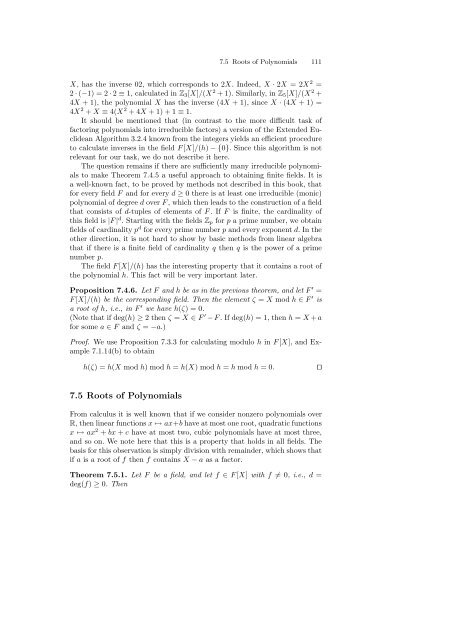Dietzfelbinger M. Primality testing in polynomial time ... - tiera.ru
Dietzfelbinger M. Primality testing in polynomial time ... - tiera.ru
Dietzfelbinger M. Primality testing in polynomial time ... - tiera.ru
Create successful ePaper yourself
Turn your PDF publications into a flip-book with our unique Google optimized e-Paper software.
7.5 Roots of Polynomials 111<br />
X, has the <strong>in</strong>verse 02, which corresponds to 2X. Indeed, X · 2X =2X 2 =<br />
2 · (−1) = 2 · 2 ≡ 1, calculated <strong>in</strong> Z3[X]/(X 2 + 1). Similarly, <strong>in</strong> Z5[X]/(X 2 +<br />
4X + 1), the <strong>polynomial</strong> X has the <strong>in</strong>verse (4X +1),s<strong>in</strong>ceX · (4X +1)=<br />
4X 2 + X ≡ 4(X 2 +4X +1)+1≡ 1.<br />
It should be mentioned that (<strong>in</strong> contrast to the more difficult task of<br />
factor<strong>in</strong>g <strong>polynomial</strong>s <strong>in</strong>to irreducible factors) a version of the Extended Euclidean<br />
Algorithm 3.2.4 known from the <strong>in</strong>tegers yields an efficient procedure<br />
to calculate <strong>in</strong>verses <strong>in</strong> the field F [X]/(h) −{0}. S<strong>in</strong>ce this algorithm is not<br />
relevant for our task, we do not describe it here.<br />
The question rema<strong>in</strong>s if there are sufficiently many irreducible <strong>polynomial</strong>s<br />
to make Theorem 7.4.5 a useful approach to obta<strong>in</strong><strong>in</strong>g f<strong>in</strong>ite fields. It is<br />
a well-known fact, to be proved by methods not described <strong>in</strong> this book, that<br />
for every field F and for every d ≥ 0 there is at least one irreducible (monic)<br />
<strong>polynomial</strong> of degree d over F , which then leads to the const<strong>ru</strong>ction of a field<br />
that consists of d-tuples of elements of F .IfF is f<strong>in</strong>ite, the card<strong>in</strong>ality of<br />
this field is |F | d . Start<strong>in</strong>g with the fields Zp for p aprimenumber,weobta<strong>in</strong><br />
fields of card<strong>in</strong>ality p d for every prime number p and every exponent d. Inthe<br />
other direction, it is not hard to show by basic methods from l<strong>in</strong>ear algebra<br />
that if there is a f<strong>in</strong>ite field of card<strong>in</strong>ality q then q is the power of a prime<br />
number p.<br />
The field F [X]/(h) has the <strong>in</strong>terest<strong>in</strong>g property that it conta<strong>in</strong>s a root of<br />
the <strong>polynomial</strong> h. This fact will be very important later.<br />
Proposition 7.4.6. Let F and h be as <strong>in</strong> the previous theorem, and let F ′ =<br />
F [X]/(h) be the correspond<strong>in</strong>g field. Then the element ζ = X mod h ∈ F ′ is<br />
arootofh, i.e., <strong>in</strong> F ′ we have h(ζ) =0.<br />
(Note that if deg(h) ≥ 2thenζ = X ∈ F ′ − F .Ifdeg(h) =1,thenh = X + a<br />
for some a ∈ F and ζ = −a.)<br />
Proof. We use Proposition 7.3.3 for calculat<strong>in</strong>g modulo h <strong>in</strong> F [X], and Example<br />
7.1.14(b) to obta<strong>in</strong><br />
h(ζ) =h(X mod h) modh = h(X) modh = h mod h =0. ⊓⊔<br />
7.5 Roots of Polynomials<br />
From calculus it is well known that if we consider nonzero <strong>polynomial</strong>s over<br />
R, then l<strong>in</strong>ear functions x ↦→ ax+b have at most one root, quadratic functions<br />
x ↦→ ax 2 + bx + c have at most two, cubic <strong>polynomial</strong>s have at most three,<br />
and so on. We note here that this is a property that holds <strong>in</strong> all fields. The<br />
basis for this observation is simply division with rema<strong>in</strong>der, which shows that<br />
if a is a root of f then f conta<strong>in</strong>s X − a as a factor.<br />
Theorem 7.5.1. Let F be a field, and let f ∈ F [X] with f �= 0, i.e., d =<br />
deg(f) ≥ 0. Then












